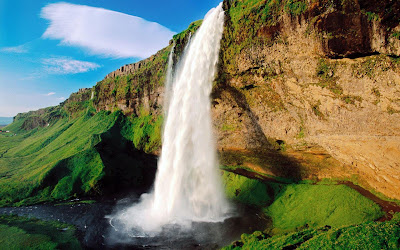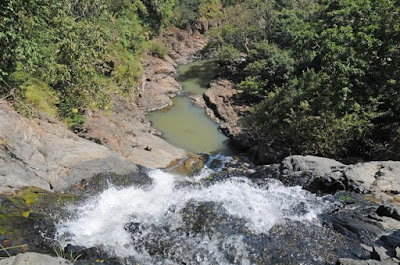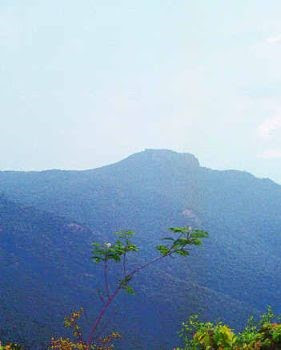Pachamalai Guide
Wednesday 18 July 2018
Tuesday 17 July 2018
Monday 16 July 2018
PACHAIMALAI HILLS
Comflower blue and Alexandrite Green, That’s Pachamalai Hills.Blue are the never-ending infiniteSkies above and gree are the hills, that’s what the name also stands for.whoever came up with the namemust have been awestruck with the unearthly greenery of theplace.one can totally understand that because visitors can completely related to it. So green, so very very green! Youknow what the best thing is about Pachamalai.pachamalai Hills is verdant greenery hillock is located on the EasternGhatsnear by Trichy or Tiruchirapalli. It’s the fact that the place is still not too explored. It’s relatively virgin and we know how hard-pressed one is to find places that are still more or less untouched. The place gives you a complete Experience in the sense that it isn’t just the eyes that arepleasured, the ears are also included in the fun given the beatufull lazy sounds of the rivers Sweata and kallar besides the Koraiyar, Mangalam Aruvi and Mayil Uthu Falls.
The
Veera Ramar dam build across river kallar is a must see. The water sprays on
your face like you are faced with a thousand exotic sprinklers when you visit
the water-Wonder the hills cover three
Districts,Tiruchirapalli, Salem, Perambalur and more then 11 Towns including
Thuraiyur and Arumbavur. Do go and hike in the jungles because the indigenous
flora and fauna is going to make you resolve to return again and again .with
all those birds, butterflies and exotic animals, you just can’t help.it, you
must go for the butterflies if nothing else.There are just too many. You’ll
return more colorful we garentee jack fruit is the major cultivation in the
seasond time .trekkers will be enthralled to be in this hill.
Mythulu
Falls (Chinnamangalam Mayil Water Falls)
PERAMBALUR: Here is good news for nature lovers and
environmentalists. The Mayil Ootru Falls at the Pachamalai Hills near Ladapuram
is getting a lot of water, thanks to the monsoon showers.Though the falls
remains dry for the major part of the year, a sharp spell of rain is sufficient
to rejuvenate it and attract tourists for a couple of months from late October
or early November.Although a person can drive up to a hamlet in the vicinity of
the hills, he has to trek for some distance along a narrow path
Myluthu falls is
located on the foot hills of Pachamalai, Tamil Nadu, a place of scenic beauty.
Approximately 15 km away from Perambalur (district Perambalur) by road to
Thuraiyur.
A dense forest region, best for trekking and other
adventurous activities. A natural stream, suited for swimming. There is also a
waterfall, high up in the hills called Akaya Gangai.
It
is perceived to have high medicinal values as it flows across plethora of herbs
with medicinal values.
Hidden Beaty
You know you've left the city
when yellow and black signboards bear names like Manachanallur, Pulivalam,
Pagalavadi and Thuraiyur; when tree trunks marked by the state highway number,
line up like sentries on either side of the road and when the carpets of
cultivated green roll out seamlessly at the periphery of your eyes. As the road
narrowed like a funnel that ended at the forest checkpost, the wind lashing my
face shed a few degrees of heat, while the sun squeezed through the thick
canopy to dapple the road ahead. Bound towards the reserve forests of
Pachaimalai near Tiruchi, I was being escorted by the forest department to the Yettu
Erumaipalli falls.
I wondered sitting in the jeep what undiscovered looked like: according to M.
Pichai, Assistant Conservator of Forests (who was accompanying me), the falls
are unknown to even people living at the foothills of Pachaimalai. “The
Malayali Gounder Tribe living here are the only ones who know about it,” he
tells me. The thrill of being let in on a secret mounted as the jeep manoeuvred
15 sharp hairpin bends right at the beginning of the climb. The landscape rose
beside us to stony heights before falling on the other side into the green
depths we were leaving behind.
A dusty view point jutted out of the hillside to dutifully expose a facet of
the rolling panorama you could capture for memory. The butterflies darted
purposefully between flowering shrubs on the edges and the tapioca grown in
abundance swayed lazily in conversation with the now chilly wind. Throughout
the climb, the road was so narrow that I wondered if our jeep would have to
retrace its path in reverse gear, to make space for an oncoming vehicle.
Encountering no vehicle from the opposite direction, we drove past men squatted
on their haunches outside a stone building. Seated beneath its broken glass
windows, their towel-turbaned heads turned to catch a glimpse of those within
the jeep. The signboard ahead announced we had reached Top Sengattupatti,
clearly the top of this 1,000 m high hill.
Our destination was about eight kilometers from the Forest Guest House in Top
Sengattupatti. On the way is a dilapidated house, which Mr. Pichai says was the
guest house built and used by the Britishers. The space outside the old guest
house seems to be lit by sunlight that looked like it had rubbed off some green
from the forest cover above, making it seem surreal. The spot has been featured
in Tamil movies, I'm told.
The closest hamlets to the Yettu Erumaipalli falls are Periyamangalam and
Chinnamangalam and the only signs of human occupation were the neatly cut out
step field with their own nel kurudus (mud huts that store farm produce), some
clothes drying on a bush and two pigs left bound by someone, probably for a
feast.
We were greeted by two bikes at the end of the incline beyond which lay the
falls. Somebody's already here, said the local forest ranger who had hopped on
to the jeep at Top Sengattupatti. If water falling from a height fell without a
sound, this spot would have evaded discovery forever, I thought to myself while
I looked around. From where we stood, the sound of water gushing downwards, and
the thin mist before us were The
only clues.
Taking the lead, Mr. Pichai and the forest ranger disappeared through a small
tunnel like opening in the outgrowth. Looking down at the path dotted by
rounded boulders of all sizes, I was reminded of my adventure trip in school. I
stepped on to the rocks gingerly, laughing nervously every time I went off
balance. The passage led to a clearing that opened out on both sides to show
where the water came from and where it began falling at a steep incline. Seated
there on a large boulder were two men (probably from the neighbouring villages)
who looked slightly bewildered by our crowd. They were steaming some root
vegetable over a campfire for their snack.
Undisturbed moss coated the rocks making them slippery, while the water was
coldly defiant of the scorching sun. A spot on the banks bore colours probably
from the horns of the Pongal-painted cows that were washed there that morning
and the birds chirped loudly, excited by the sudden increase in human voices.
Maybe they weren't too happy about the discovery.
Hindu Article
PACHAMALAI EVOKES forested hills and verdant
valleys. But, as one has learnt the hard way with RLTs, nice sounding names do
not always lead to nice places."Why do you want to go to Pachamalai, there
is hardly anything
there," said a forester when I told him I was planning a visit.
However, others assured me that a trip to
Pachamalai is well worth the journey. I headed from Tiruchi towards the North
on the Musiri-Athur-Salem Road via Thuraiyur, an 80 km-odd drive. As I
approached the Pachamalai hills, I tried to picture them in my mind's eye —
they are said to resemble an inverted tumbler or horse shoe.The 14 km drive up
the ghat road began at Shobanapuram and had 11 hair-pin bends. About three km
uphill, a breath-taking view of the valley unfolded. I stopped to take in the
scenery at Top Sengattupatti.
True, Pachamalai is not as `green' as its name
suggests but as I discover it is a wonderful refuge from the bustle of a
city.About 1,000 metres above mean sea level, the range comprises patches,
which alternate in shades of brown and green. Cliffs and vales dot the
landscape.Brown, I gathered, is due to tapioca cultivation done by the tribals
on patta land. This erodes the top soil exposing the bare rock.The forest
extends over 425 sq km and comprises four types of trees: deciduous, semi-moist, sub-tropical dry deciduous and dry deciduous.
Mahogany and sandalwood trees are found in
plenty. Pachamalai also has a wealth of medicinal plants, tubers, flowers,
birds and butterflies, besides monkeys, squirrels and bears.The original
inhabitants still live there, in relative isolation from the mainstream. I
learnt from them about a trekking route, a four km stretch that leads toRamanathapuram
via Kanadapatti. The area is deafeningly silent. Trekking is not too difficult
here, but one can hardly spot animals. However, an unusual sight greets one at
the foothills near the Periaswamy Koil in Shobanapuram. Hanging from the branches
of two huge banyan trees are hundreds of bats — the Indian flying fox. The
species is unique to this area.
A sense of eeriness prevails, for even in broad
daylight, it is dark under the trees, thanks to the bats. Just clap once and
the bats take off and after circling about for a while, return to the branches.
The view reminds you of a scene from a horror movie.As for the Pachamalai
hilltop, one can hardly find people there, as it has not been promoted as a
picnic or trekking spot.If you are looking for some peace and quiet, Pachamalai
is a possible destinationHotel accommodation is available in Thuraiyur and
Perambalur, besides the forest lodge for which permission is required.
Medical Plants
Pachamalai hill range extends into Trichy and
Salem districts of Tamilnadu. The approach to the hills is from Uppiliapuram.
The base station is Shobanapuram 4 Kms from uppiliapuram. The 12 km drive from
foot hill to Top senkattupatti is a wonderful location for people interested in
medicinal plants. As one reaches the first habitation of Thenpuranadu, hamlets
on the right side belong to Trichy district, while the left side belong to
Salem district. CTMR team comprising of Vd.S.Usman Ali, Dr.T.Thirunarayanan.
Dr.S.Rajkumar along with Dr.T.R Siddique Ali interacted with the Village
administrative officer, Tribal headmen individually and tribal men collectively
at Top sengattupatty, Periyanagoor, Mayalampaddi, Nalla mathur. To the surprise
of the team inspite of the rich availability of medicinal plant flora, the
tribals have completely forgotton the traditional medical knowledge excepting
two village elders who treat patients for poisonous bites. One of the Govt.
Primary Health Centre also has a Siddha physician and only a very few patients
take traditional medicine. Apart from cattle rearing and Tapioca monoculture no
other economic activity is being carried out. The monoculture of tapioca has
led to destruction of the native flora. Surprisingly collection of Minor Forest
produce like Chebulic myrobalan is also not being taken up by the tribal as
they consider that less remunerative due to the high transportation cost.
Naripadi village 7 Km from kodamalai on the other side of Pachamalai slope in
the Gangavalli Taluk of salem was no better as most of the tribal have taken up
other vocation. Youngsters have joined central Govt departments like railways
and postal department. An eighty year old Poojari of the temple is the only
person still preserving traditional knowledge and also growing medicinal plants
for dispensing to his patients.
Subscribe to:
Posts (Atom)

















